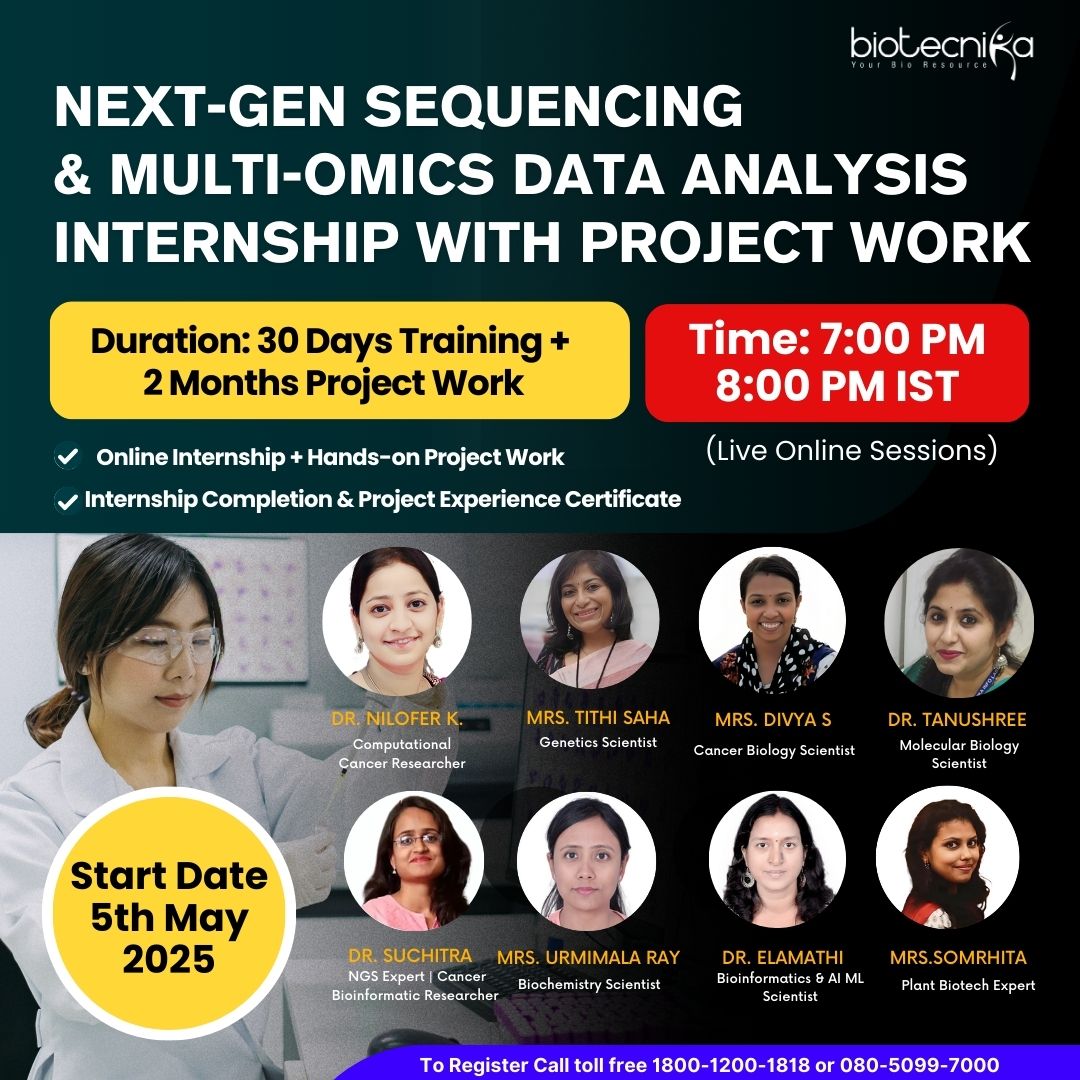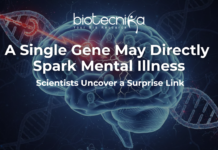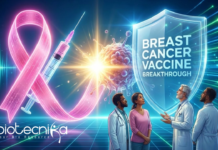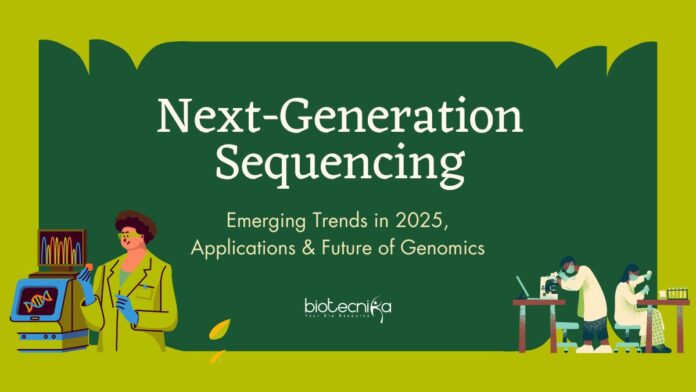Table of Contents
Next-Generation Sequencing – NGS Technology 2025
Imagine a world where deciphering the secrets of lifeforms becomes as easy and efficient as stacking building blocks. If you’re passionate about the latest advancements transforming the Life Sciences landscape, NGS Technology 2025 offers exciting possibilities. This next-generation sequencing revolution empowers you to explore cutting-edge methods and apply them to real-world challenges.
NGS (Next-Generation Sequencing) has evolved from a specialized laboratory tool to a revolutionary technology and is the bright future of Genomics. NGS significantly impacts the Agriculture, Space exploration, Medicine, as well as Forensic Science sectors.
NGS has become more sophisticated and advanced in recent years, enhancing Sustainable Agriculture, Scientific Discoveries, as well as Personalized Medicine.
Are you a Healthcare professional, a Researcher, or someone curious about the future of Life Science and Genomics? Then this article is the right place to explore NGS trends and applications. Get ready to dive into the article as well as the futuristic innovations reshaping Genomics and DNA sequencing!
NGS Emerging Innovations & Trends
Next-Generation Sequencing or NGS is a rapidly evolving and advancing technology, introducing Genome analyses innovations to the world of Life Sciences. The year 2025 is witnessing futuristic developments that enhance cost-effectiveness, accessibility, as well as accuracy, making Genomic research more impactful than ever! These advancements, from AI-driven Bioinformatics to ultra-precise sequencing techniques, are unlocking new possibilities in disease diagnosis, Personalized Medicine, and agricultural sustainability. In this section, we explore the most exciting trends in NGS that are shaping the future of Healthcare, Agriculture, and Scientific Discovery, setting the stage for a new era of Genomics-driven breakthroughs.
01 Single-Cell Sequencing
Have you ever wondered what makes two identical cells behave differently at times? The answer is ‘Single-Cell Sequencing’, which allows scientists and researchers to analyze individual cells accurately. Advancements in Single-Cell Sequencing are enhancing scalability as well as accessibility, enabling more precise cellular analyses. It aids Researchers and Scientists in unveiling the mysteries of Neurodegenerative diseases, rare genetic diseases, aging, as well as cancer. AI-driven Bioinformatics enables data interpretation more easily, giving Scientists and Researchers a better look at the blueprint of life, considering one cell at a time.
Numerous studies have shown that AI-assisted Single-Cell Sequencing has accelerated data processing efficiency by more than 40%, significantly increasing innovations in Personalized Medicine and Healthcare.
NGS-powered Single-Cell Sequencing is proving significant in the early detection of neurodegenerative diseases such as Alzheimer’s disease. By analyzing individual brain cells, Scientists can identify biomarkers associated with neurodegeneration in people before the symptoms appear, paving the way for early intervention medical strategies.
02 Sequencing Steals the Spotlight
Even though Short-Read Sequencing is valuable, it still has limitations in capturing particular structural variations. This limitation is overcome by Long-Read Sequencing technologies such as Oxford Nanopore’s real-time sequencing as well as PacBio’s HiFi sequencing. These Long-Read Sequencing technologies are aiding researchers with high-resolution views of complex genetic regions, unlocking insights into structural variants as well as rare genetic diseases that were impossible to detect earlier.
In 2025, hybrid technological approaches combining short as well as long reads are making sequencing cheaper, more accurate, as well as faster than before.
Hybrid sequencing has proven significantly effective in Cancer Genomics, identifying large structural variants with ease. These approaches have enabled the detection of complex genetic variations, including gene fusions in Cancers such as Leukemia, enabling more precise treatment strategies.
NGS Technology 2025
03 AI Genomic Discoveries
Have you ever thought what would happen when AI (Artificial Intelligence) meets Genomics? AI is transforming NGS workflows by speeding up variant interpretation, predicting disease risks, as well as automating error correction with more precision. AI-powered tools are now being leveraged to analyze massive Genomic Datasets, making incredible innovations in Drug Discovery, Personalized medicine, as well as Cancer research. AI-powered Genomic analysis is improving variant interpretation, with studies showing impressive enhancements in Diagnostic accuracy majorly.
One of the most important applications of AI-powered Next Generation Sequencing is in neurodegenerative diseases such as Alzheimer’s disease. AI models which are trained for large Genomic datasets are now able to identify subtle Genetic variants linked to disease progression, guiding Personalized Treatment plans as well as improving early detection.
04 Portable Sequencing Devices
Think of a Researcher in a rainforest sequencing a deadly unknown virus using a portable Sequencing device. Well, Oxford Nanopore’s MinION is making Real-Time Sequencing in remote locations a reality; field sequencing still requires sample preparation, reagents, and computational analysis. Advancements in cloud-based data processing as well as field-friendly sequencing kits are making Environmental Monitoring, Space exploration, as well as outbreak surveillance more accessible and efficient. With real-time connectivity, sequencing data can now be transmitted to cloud-based AI models, allowing instant pathogen identification in global health emergencies.
05 The Rise of Multi-Omics and Epigenomics
DNA sequencing alone isn’t enough; scientists now want the full picture – genes, proteins, and their interactions. Multi-omics is taking off, integrating genomics, transcriptomics, proteomics, and metabolomics to offer a 360-degree view of biological systems. However, challenges such as data standardization, integration of diverse data types, and interpretation of complex datasets remain. In 2025, advanced Bioinformatics tools and cloud-based platforms are addressing these challenges, allowing for seamless integration of Multi-Omics Data. NGS-driven Epigenomics is also revealing how environmental factors influence gene expression, opening new avenues in precision medicine and aging research.
06 Error-Free & Cost Reduction Sequencing
Remember when sequencing the first human genome cost billions? Today, it’s a fraction of that price, and in 2025, it’s getting even cheaper and more precise. Thanks to innovative Chemistry, advanced error-correction Algorithms, and high-throughput platforms, researchers can now sequence entire Genomes at record speeds without breaking the bank. The cost of whole-genome sequencing is now expected to approach $100 per Genome, making high-quality sequencing accessible to hospitals, research labs, and even individual consumers.
Ready to Master NGS and Multi-Omics Hands-On?
If these cutting-edge trends inspire you in NGS and you dream of applying them in real-world projects, don’t miss out on Biotecnika’s specialized program — Next-Gen Sequencing & Multi-Omics Data Analysis – Hands-on Internship With Project Work.
This immersive training covers practical NGS techniques, multi-omics integration, and real-
Highlights:
- Hands-on Training + Internship
- Practical Project Work
- Learn NGS Data Analysis, Multi-Omics, and Real-World Applications
- Industry-Level Skills for Careers in Genomics, Research, and Bioinformatics
Click here to explore the program and enroll today!
STARTS 5th MAY 2025
How NGS is Reshaping the World? NGS Technology 2025
As NGS technologies continue to evolve, their applications are expanding far beyond traditional research settings. The ability to sequence DNA quickly and accurately is now driving innovation across multiple fields, from healthcare to agriculture and even forensic science. The real-world impact of NGS is more significant than ever, shaping the way we diagnose diseases, develop treatments, and protect global health. In this section, we explore how these advancements are actively reshaping industries and improving lives on a global scale.
01 Precision Medicine Gets Personal
NGS is at the heart of precision medicine, helping doctors develop customized therapies for Cancer, Cardiovascular diseases, and rare Genetic disorders. Liquid biopsy-based NGS is making early cancer detection a reality, giving patients a fighting chance before symptoms even appear.
02 Next Pandemic Preparedness
After the COVID-19 pandemic, the world learned a crucial lesson: we need better tools to track viruses. In 2025, NGS is at the forefront of pandemic preparedness, identifying new pathogens, tracing outbreaks in real time, and developing targeted vaccines faster than ever before. With rapid sequencing technologies, health authorities can monitor viral evolution in real time, aiding in early outbreak detection and vaccine development.
03 Enhancing Agriculture & Food Security
NGS is enabling scientists to sequence plant and livestock genomes, helping to engineer crops that withstand droughts, resist diseases, and provide higher nutritional value. In 2025, gene-edited crops are helping tackle food insecurity and climate change while ensuring safer, healthier food for all.
04 Solving Cases with Genomic Forensics
Advanced forensic sequencing is now being used to identify perpetrators from degraded or mixed DNA samples, bringing justice to long-unsolved cases. Law enforcement agencies are also using NGS to track the origins of Biothreats, ensuring national security.
05 Space Genomics: Exploring Life Beyond Earth
Next-generation sequencing is not just limited to Earth. Scientists are using portable sequencers to analyze microbial life in space, study astronaut health, and understand how long-term space travel affects human genetics. As we push the boundaries of space travel, the ability to sequence DNA beyond Earth could help us detect extraterrestrial life, mitigate health risks for astronauts, and even pave the way for sustainable human colonization on other planets.
The Road Ahead – Challenges & Future Prospects
NGS Technology 2025
Next generation sequencing is advancing with lightning speed. The main concern is data storage, as sequencing generates massive datasets that need secure handling. Ethical concerns about genomic dataset privacy are prompting regulatory discussion around the world. While frameworks like the General Data Protection Regulation and the Health Insurance Portability and Accountability Act provide data protection and guidelines, additional genomic-specific regulations are in progress. Along with that, quantum computing as well as blockchain hold promise for genomic data security. An immediate solution has federated learning for genomic data privacy as well as cloud-based genomic data analysis, ensuring that genomic research continues to grow efficiently. Federated learning method is emerging as a potential method for securing genomic data analysis, although challenges in implementation as well as standardization remain, making it a promising solution for big dataset genomic studies.
Next Generation Sequencing is not just a technology; it’s a revolution reshaping medicine, agriculture, and beyond. The latest advancements in 2025—from AI-driven genomics to ultra-fast portable sequencers—are transforming the way we understand life at its most fundamental level. Looking ahead, the integration of NGS with CRISPR gene editing, synthetic biology, and real-time disease monitoring will further push the boundaries of scientific discovery. In the future, real-time sequencing coupled with AI will help to detect diseases before symptoms arise, paving the way for preventive medicine as well as personalized healthcare. As genomic sequencing technology becomes faster, cheaper, as well as more powerful, we are moving closer to an era where genomic sequencing is as routine as a blood test, unlocking personalized healthcare for everyone.
NGS Technology 2025 – Latest Article

























